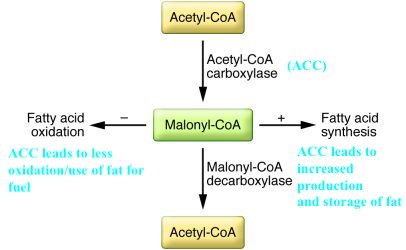
In my last post, I outlined possible causes of metabolic syndrome (MS) as well as pathophysiological manifestations of said condition, to include dysregulation of fatty acid synthesis (dyslipidemia). One cause of dyslipidemia includes an overabundance of insulin production, which is also a marker of MS (Lord & Bralley, 2012). However, it is also possible that particular lipids can be underproduced from deficiencies/dysregulation in enzymes involved in said process. One such enzyme is acetyl CoA carboxylase (ACC); an enzyme that is a critical first step in the endogenous production of fatty acids from the citric acid cycle. As a means of appreciating the nuances of lipid synthesis, the following will explore ACC, with particular emphasis on its biotin cofactor, in greater detail.
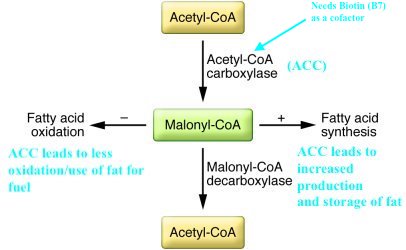
ACC facilitates the conversion of citrate (from the citric acid cycle) to acetyl-CoA, which is then converted to malonyl CoA, ultimately leading to the synthesis of fatty acids and cholesterol (Lord & Bralley, 2013). However, said enzyme requires biotin (B7) as a cofactor. B7 is a water-soluble micronutrient, which is required for cellular function, development, and growth (Said, 2008). Specifically, B7 is a carboxyl carrier/cofactor for 5 carboxylases; 4 carboxylases are found within the mitochondria and 1 in the cytosol (Said, 2008).
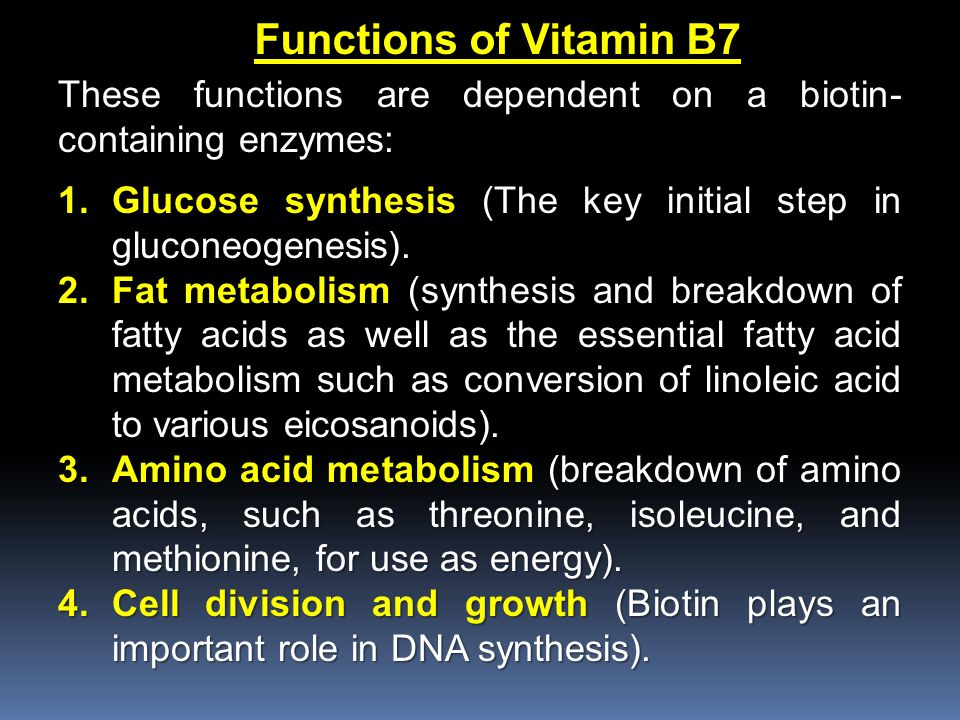
Such enzymes are not only involved in fatty acid synthesis, but also facilitate the metabolism of carbohydrates and proteins. Interestingly, B7 not only facilitates enzymes in the metabolism of micronutrients; it is also thought to be involved in cell proliferation and immune function. As such, deficiencies in said B vitamin can negatively affect growth, induce neurological disorders, and cause dermatological issues (Said, 2008). The following will consider the types, sources, and absorption in B7 in greater depth.
In nature, B7 can exist in 8 different forms (stereoisomers) with the D-biotin isomer being the most biologically active. B7 is found is a variety of foods to include organ meats such as the kidney and liver, as well as vegetables, cow milk, and egg yolks (Said, 2008). Interestingly, B7 is not only found in foods; the bacteria of the large intestine also produce said micronutrient, although the degree to which B7 is produced remains unclear (Said, 2008). Such redundancy might exist because food source bioavailability of B7 can range from 5%-100% (Said, 2008).
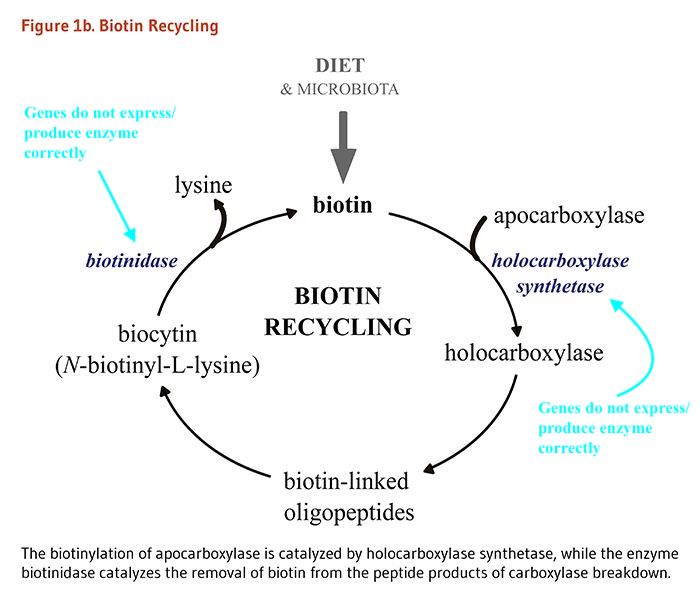
Inherited defects in B7 metabolism exist and are known as holocarboxylase synthetase (binds biotin to carboxylase) deficiency (HCSD) and biotinidase deficiency (BD) in which both eventually manifest into multiple carboxylase deficiency (MCD) (Baumgartner & Suormala, 2000). BD is of particular interest because B7 depletion occurs due the body’s inability to recycle said micronutrient and difficulty in absorbing biotin from the diet (Baumgartner & Suormala, 2000). Left unchecked, MCD can produce serious ailments to include metabolic acidosis, ataxia, seizures, hypotonia, alopecia, impaired consciousness, and dyslipidemia (Baumgartner & Suormala, 2000; Tong, 2013). However, B7 deficiency can be mitigated via oral dosing of said micronutrient.
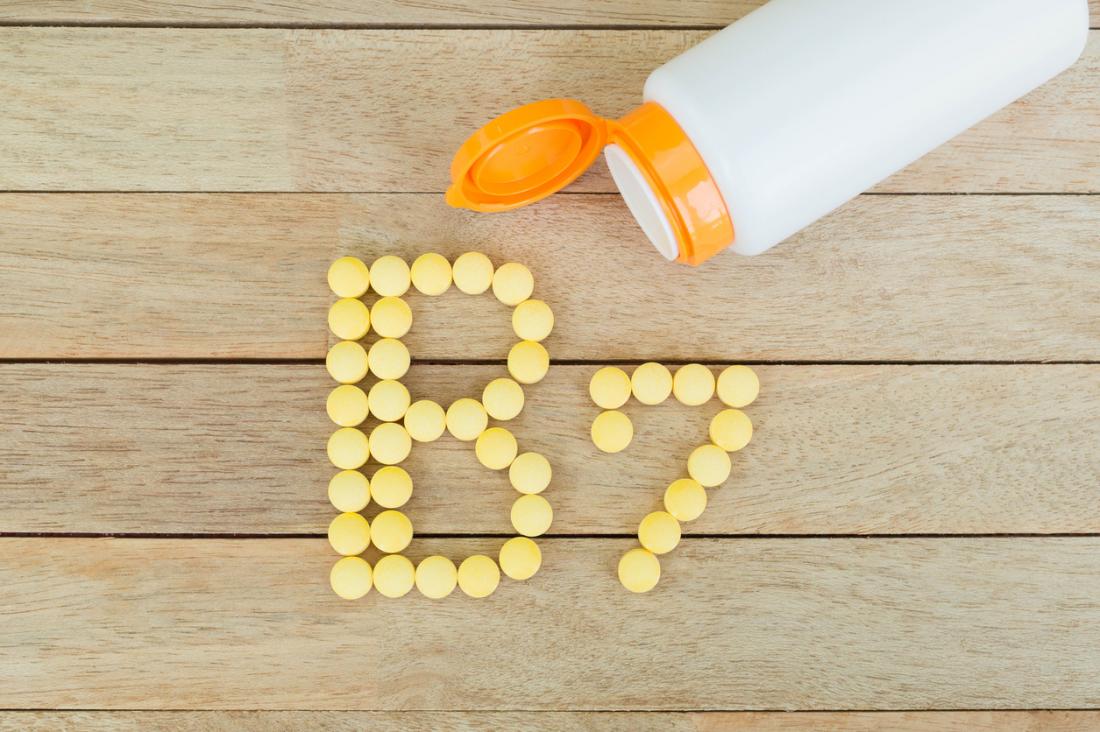
In conclusion, ACC and MCD can be caused by the improper absorption and management of B7 via genetic defects in holocarboxylase and biotinidase. Left unchecked, MCC can manifest into other conditions outlined in the last section. However, early detection of MCC in conjunction to oral supplementation of B7 can help improve health outcomes among individuals with said condition.
References
Baumgartner, E. R., & Suormala, T. (2000). Biotin-responsive multiple carboxylase deficiency. Springer, Berlin, Heidelberg. doi:https://doi.org/10.1007/978-3-662-04285-4_24
Lord, R. S., & Bralley, J. A. (2012). Laboratory evaluations for integrative and functional medicine (2nded.). Duluth, GA: Genova Diagnostics.
Said, H. M. (2008). Cell and molecular aspects of human intestinal biotin absorption. The Journal of Nutrition, 139(1), 158-162.
Tong, L. (2013). Structure and function of biotin-dependant carboxylases. Cellular and Molecular Life Sciences, 70(5), 863-891.
-Michael McIsaac
